
The Ford Taunus is a family car that was sold by Ford Germany throughout Europe. Models from 1970 onward were built on the same basic construction as the Ford Cortina MkIII in the United Kingdom, and later on, the two car models were essentially the same, differing almost only in the placement of the steering wheel. The model line was named after the Taunus mountain range in Germany, and was first made in 1939, and continued through several versions until 1994.
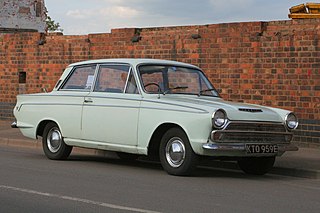
The Ford Cortina is a medium-sized family car manufactured in various body styles from 1962 to 1987. It was the United Kingdom's best-selling car of the 1970s.

The Ford Sierra is a mid-size/large family car manufactured and marketed by Ford Europe from 1982–1993, designed by Uwe Bahnsen, Robert Lutz and Patrick le Quément — and noted for its aerodynamic styling producing a drag coefficient of 0.34, a significant improvement over its predecessors.
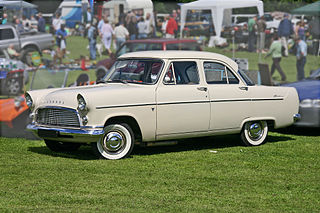
The Ford Consul is a car that was manufactured by Ford of Britain from 1951 until 1962. The name was later revived for a model produced by Ford in both the UK and in Germany from 1972 until 1975.

The Ford Taunus V4 engine is a 60° V4 piston engine with one balance shaft, introduced by Ford Motor Company in Germany in 1962. The German V4 was built in the Cologne plant and powered the Ford Taunus and German versions of the Consul, Capri, and Transit.

The Opel Rekord is a large family car which was built in eight generations by the German car manufacturer Opel. Between 1953 and 1986, approximately ten million were sold.

The Opel Olympia is a compact car by German automaker Opel, then part of G.M., from 1935 to 1940, and after World War II continued from 1947 to 1953. It was one of the world's first mass-produced cars with a unitary body structure, after the 1934 Citroën Traction Avant; and it was a mass-production success, made in six-figure numbers. Opel achieved this even before the war, all while Hitler promised Germany a "Volkswagen" - a 'People's car', which didn't materialize until 1946. From 1967 to 1970 the Olympia badge was briefly reused on a later car.
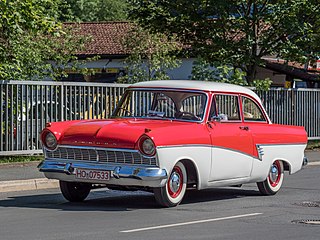
The Ford Taunus 17 M is a middle sized family saloon/sedan that was produced by Ford Germany between August 1957 and August 1960. The Taunus 17M name was also applied to subsequent Ford models which is why the car is usually identified, in retrospect, as the Ford Taunus P2. It was the second newly designed German Ford to be launched after the war and for this reason it was from inception known within the company as Ford Project 2 (P2) or the Ford Taunus P2.

The Ford Taunus 17 M is a middle sized family saloon/sedan that was produced by Ford Germany between September 1960 and August 1964. The Taunus 17M name had been applied to the car's predecessor and it would apply also to subsequent Ford models which is why the 17M introduced in 1960 is usually identified, in retrospect, as the Ford Taunus P3. It was the third newly designed German Ford to be launched after the war and for this reason it was from inception known within the company as Ford Project 3 (P3) or the Ford Taunus P3.

The Ford Taunus 12M is a small family car that was produced by Ford Germany between September 1962 and August 1966.
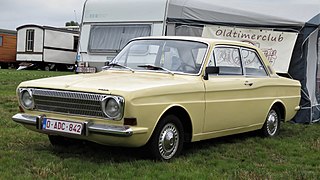
The Ford Taunus 12 M is a range of large family saloons/sedans that were produced by Ford Germany between 1966 and 1970. There were two different engine sizes in the 12M. Two larger engines were available in the otherwise very similar Ford Taunus 15 M. From the outside the 15M was differentiated by its grill and rectangular headlights from the 12M which had round front lights. A complicating feature was the availability, at extra cost, of one of the larger engines from the 15M in the 12M.

The Ford P7 is a range of large family saloons/sedans produced by Ford Germany between autumn 1967 and December 1971. The P7 was marketed as the Ford 17M, Ford 20M and Ford 26M.

The Opel Rekord P1 was a large family car introduced in August 1957, in time for the Frankfurt Motor Show, by Opel as a replacement for the previous year's Opel Olympia Rekord. It was larger than its predecessor and featured an eye-catching US-style wrap-around windscreen and rear window, reminiscent of its General Motors Luton-built cousin, the Vauxhall Victor F, which had appeared in England a few months earlier.

The Opel Rekord P2 is a large family car that was introduced in the summer of 1960, by Opel as a replacement for the Opel Rekord P1. It shared its 2,541 mm wheelbase with its predecessor, but was nonetheless a little longer and wider. The wrap-around windscreen which had been a defining element of the Rekord P1, and which had given rise to the P for "Panorama" designation, was now gone, but the P designation remained and the driver's view out, assisted by relatively thin A-pillars, remained good.

The Opel Rekord Series A is a large family car introduced in March 1963, by Opel as a replacement for the Opel Rekord P2. It was fractionally shorter but also wider than its predecessor with a wheelbase approximately 10 cm longer.

The Opel Rekord Series B is a large family car that was introduced in August 1965 by Opel as a replacement for the Opel Rekord Series A and stopgap until the delayed Rekord C was ready for sale. Produced only until July 1966, it shared the wheelbase and 1,696 mm (66.8 in) width of its predecessor, but the front and rear panels were restyled to give it a more modern appearance.

The Opel Rekord Series C is a large family car that was introduced in August 1966, by Opel as a replacement for the short-lived Opel Rekord Series B. It was slightly larger all round than its predecessor, from which it inherited most of its engines. It continued in production until replaced by the Opel Rekord Series D at the end of 1971.

The Opel Rekord D series is a large family car that replaced the Rekord C on Opel's Rüsselsheim production lines during the closing weeks of 1971 and launched on the West German market at the start of 1972. It shared its wheelbase and inherited most of its engines from its predecessor, but the bodies were completely new. Also new, announced in September 1972, was the option of a diesel powered Opel Rekord. Early advertising and press material called the new car the "Opel Rekord II" but in due course, the "Rekord II" appellation was quietly dropped and the Rekord D was replaced at the end of the 1977 summer holiday shut down by the Opel Rekord E.

The Ford Taunus TC is a range of large family cars that were built by Ford Germany from 1970 until 1982. The Taunus TC was based on the same basic construction as the Ford UK's Cortina range, with the "TC" badge standing for Taunus Cortina.
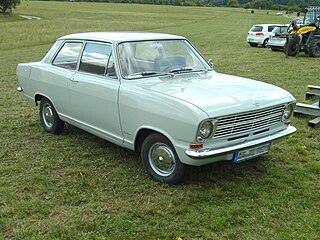
The Opel Kadett B is a car that was launched by Opel at the Frankfurt Motor Show in late summer 1965. The Kadett B was larger all-round than the Kadett A: 5% longer both overall and in terms of the wheelbase, 7% wider and 9% heavier, albeit 10 mm (0.39 in) lower in basic standard "Limousine" (sedan/saloon) form. Production ended in July 1973, with the successor model introduced a month later following the summer shut-down, in August. Unlike its predecessor, it bore no relation to the Vauxhall Viva, which had moved to its own platform for its corresponding second generation.




















